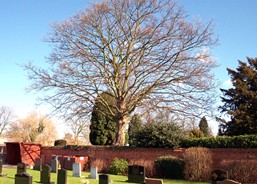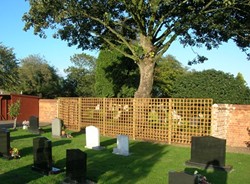|
Town
councillors demolish part of
the ancient cemetery wall
|
 |
 |
|
The cemetery wall in March 2006 (left)
and the demolished section as it is today |
In February 2006, Bourne Town
Council, which administers the cemetery, discussed what to do about the
roots of a large sycamore that stood alongside the ancient red brick
dividing wall between the old and the new cemeteries because its continued
root growth was threatening the stability of the brickwork. Remedial work
was necessary as part of the periodic maintenance and as the tree is
protected by law, councillors suggested that the wall must be shifted or
even removed altogether.
Realignment was costed at £5,000, a hefty bill for such a small authority,
and so a working party was appointed to consider the alternatives. This
brought the task of councillors dealing with the preservation of our past
under particular scrutiny for although a brick wall may not appear to be a
high point of our inheritance, it was important when the cemetery was
opened 150 years ago and has become a familiar feature since.
Tree Preservation Orders, or TPOs, such as that which referred to the
sycamore, are merely a guide to the law and good practice and are not
written in stone. They may be rescinded in the same way that they are
imposed, in the interests of the public, nature conservation and care for
the environment. One of the major factors in deciding whether an
individual tree, as opposed to woodland, should be felled is how suitable
it is in its present location and whether removal will have an impact on
the visual setting of the area. In this case, it is doubtful whether the
tree was planted in that spot intentionally because it was bound to cause
damage in the long run and so it is almost certainly a self-setter,
overlooked by past workmen until it gained sufficient stature to become
part of the scene. Yet it was an interloper and therefore proved that the
wall was far more important to the appearance of the cemetery than the
tree and so it should have been removed and replaced by a sapling in a
more appropriate place in the vicinity whereas an ancient feature such as
the wall was irreplaceable.
The course of action by the town council was therefore quite clear. A
representative from the local planning authority, in this case South
Kesteven District Council, should have been invited to make an on the spot
investigation and report back and the answer to this problem was obvious
at first sight and would not escape even the most inexperienced local
government officer. It is within the district councilís power to revoke
TPOs and as this is a relatively simple procedure in the scale of
bureaucratic endeavour, the removal of the sycamore appears to have been
the most sensible course of action in the interests of financial prudence
and common sense but the town councilís working party hardly gave it any
consideration.
Instead, it recommended that the section of the wall made unsafe by the
roots of the tree should be removed and the resulting bricks used to build
supporting pillars and then a trellis with climbing plants be erected to
fill the gap which would serve the dual purpose of looking attractive and
stopping people walking through it.
Councillors totally rejected the obvious answer that as the tree was
causing the difficulty it should be cut down. It was a self-setter anyway
while the red brick wall is part of the cemeteryís history, dating back to
1855, and should have been protected at all costs as a fine example of
Victorian craftsmanship. Perhaps councillors did not think a wall worthy
of protection, even one so old, but if a survey of our listed properties
were carried out today by English Heritage, the responsible authority,
then it would be the subject of a preservation order and to stifle any
cries of disbelief, we should remember that when the last assessment was
carried out in Bourne during the summer of 1977, the wall and gateposts at
No 29 South Street, the former Red Hall gatehouse, were given a Grade II
listed status and cannot be demolished no matter how many trees grow up
around the base.
It was suggested that councillors were powerless to act because of the TPO
but a little research and common sense would have
settled the matter rather than resort to a complicated scheme that was
neither practical nor visually acceptable and at the same time saved
councillors from further public censure and even ridicule.
Common sense however, did not prevail, and in October that year the deed
was done. Quietly, and without any public announcement, the town council
commissioned workmen to pull down a 30 foot section of the wall and fill the gap with five
pieces of garish creosoted wooden trellis. This
was vandalism on an official scale, decided on by councillors voting in
secret without resort to public opinion on the matter.
This wall has weathered the passing years, and it is mainly in good
condition despite frequent incursions by marauding children. The
transaction of 1855 was a legal one and demolition of any part of it might
even be deemed to be unlawful. As it is, the deed is done and so those
town councillors who voted for this section to be demolished should
remember that the action they have taken in destroying part of our
heritage will not be forgotten.
WRITTEN OCTOBER 2006
Return to The
town cemetery

Go to:
Main Index Villages
Index
|

